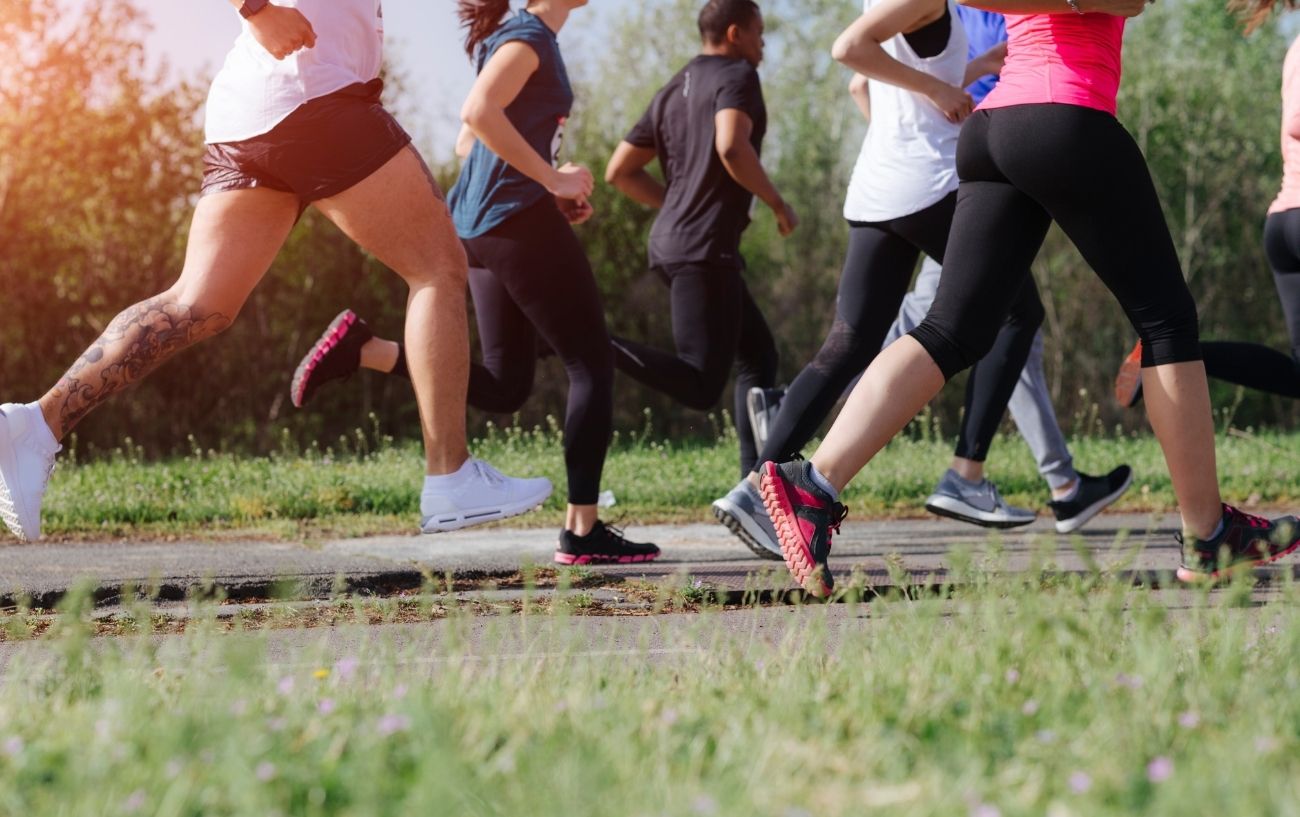Starting running as a beginner can be daunting, particularly if you haven’t been consistently active for a long time or you consider yourself to be very “out of shape.“
The good news is that with patience and our best tips for beginner runners, you can start your running journey today, and you may even fall in love with running faster than you think!
In this guide to how to start running, we will discuss how to get into running and tips for following a running routine so that you not only reach your goals but actually enjoy the journey.

11 Tips for How to Start Running and Enjoy It!
#1: Don’t Be Afraid to Ask for Help
When you first start running, there are a ton of common questions that come up.
For example, what’s a good pair of running shoes? Is there a way to prevent blisters? What’s this Strava everyone talks about?
Then, there are questions beginners have that they often feel shy about asking, such as, “How do I prevent chafing under my bra or between my thighs?” “Do I wear underwear while running?”
Experienced runners generally love answering questions, so don’t be shy to ask around. Join a running club, or consider getting a running coach who can answer all the questions you could possibly come up with.
We also have a great guide that answers the most common 50 questions people usually have about running.
#2: Find Your Place In the Running Community
One of the coolest things about the sport of running is how diverse it is.
From kids participating in fun runs and helping a parent across the finish line to centenarians testing themselves on the 100-meter dash or even just going about their daily training runs, the running community is massive and very inspiring.
There are runners in every country of the world from different socioeconomic backgrounds, races, religions, upbringings, interests, and so on.
The other unique thing about the sport of running is the diversity within the sport itself. There are 5Ks, 10Ks, half marathons, marathons, trail runs, ultra runs, stage races, obstacle races, running groups who just go out and train, and the list goes on and on.
Although millions call themselves “runners,“ what “being a runner“ means to each person can look and feel totally different.
Some people run a couple of miles a week on the treadmill to warm up before lifting weights, just to stay in shape, or to lose weight; others run more than 100 miles a week in preparation for competing in marathons or longer distances at the highest level.
All of this is to say that you don’t have to train for marathons, long distances, or run on the road to be a “runner.“
Try trail running, fun runs, sprinting, obstacle races, group runs, treadmill runs, or any facet of running that appeals most to you.

#3: Try an Organized Fun Run
Particularly for beginners, there are many benefits to trying an organized fun run (like a color run or community MeetUp group run) in your area rather than starting right off the bat with a competitive 5K race.
Participating in a fun run can be a great way to introduce yourself to the feeling of accomplishing something and completing a running goal, all while having a fun time in a casual atmosphere without the stress of anxiety associated with a formal road race.
Fun runs are also great for new runners who identify as being “slow.”
Beginners who think of themselves as “bad runners” or “joggers vs. runners” often feel self-conscious or intimidated about entering a “real” race for the first time.
Indeed, many beginners start to get excited about running as a hobby and want to participate in the running community, but they don’t yet feel ready to enter an official race.
They often worry that they won’t be able to complete the whole race without stopping, or they may fear finishing last, among other common pre-race anxieties about running their first 5K.
Walking is okay, and beginners can definitely run races.
By all means, you are encouraged to enter actual races regardless of your body size or shape or how fast or slow you are!
In these situations, trying a fun run first can be a good stepping stone to help you work up the courage or excitement to enter a timed running race.
You can use the fun run event as an exciting foray into the sport of running that catapults you into more serious training for the next event.

#4: Recruit a Training Partner
They say that “misery loves company,“ but so does joy—which can come from running.
One of the best tips for beginning runners is to find a training buddy to start your running journey with you.
Perhaps there is someone in your life that you would like to introduce to the sport of running, but they have been hesitant or reluctant, thinking that running might be too “hard“ or too “competitive.“
Instead of starting running alone, having a training partner can be a fantastic way to have accountability and someone with whom you can share the highs and lows of being a new runner.
Plus, running with a buddy or dog is a good way to improve safety relative to running alone.
#5: Strength Train
Yes, I know you are already thinking about picking up a new sport, so why two you ask?
Strength training as a compliment for beginner runners, and all runners for that matter, is the best way to fix muscle imbalances and help reduce the risk of injury while your body adapts.
It will also make you stronger in general and help you run faster.
Two total-body workouts per week are plenty. Be sure to hit all the muscles involved in running, such as your quads, hamstrings, calves, and core. Exercises such as squats, lunges, planks, calf raises and glute bridges are a great way to start.

#6: Take Time to Train Before Running a Race
Sometimes, new runners want to jump right in and run their first 5K race within a week or two of starting running.
However, if you have not been doing any type of running but want to run a 5K race or 5K fun run, and you want to be able to run the entire distance, you should begin your training at least six weeks before the event, if possible.
This will allow you enough time to gradually increase your mileage and adapt to running’s physiological demands. Usually, for new runners, a Couch to 5K program includes a run-walk program, alternating between minutes of walking and running.
Of course, if you have less time to train for your first 5K race, you can adopt a more aggressive training plan for beginners, but you should assess your fitness level, readiness, and risk of injury before doing so.
Doing too much running too soon and ramping up your training volume too quickly can result in injury or burnout.
It is always best to err on the side of caution and feel a bit under-trained going into the race rather than overdoing it in your training leading up to that first run.
After all, you want to get to the starting line in a healthy place and actually enjoy the event. If you have to stop and walk some, it’s totally fine.
There’s nothing more disheartening than getting injured leading up to your first 5K or fun run, so prepare accordingly and take your time. Also, be sure to follow all parts of your training plan, such as warm-ups, cool-downs, and of course, rest days.
#7: Consider Using a Watch
One of the most valuable training tools, the GPS running watch, has helped facilitate a more scientific and specific approach to training.
While there are many merits of training by feel/effort as a beginner and not worrying about pace, using a watch can help you track your progress and keep track of the distance and time you are running.
If you want to do run/walk intervals, you can use the running watch to help you determine when to take a walking break.
You can also track your heart rate and other helpful metrics during your workouts.
Plus, getting a good GPS running watch (we love the Garmin Forerunner 265!) will allow you to upload or keep track of all of your running and cross-training workouts in one place, allowing you to set a training goal and adjust your beginner training plan as your fitness improves or obstacles arise.
Other important running gear will include your running clothes and a comfortable pair of shoes, a visor or hat, headphones if you plan on listening to playlists or podcasts, and something to carry your water bottle along such as a waist belt.
Check out your local running store; they can set you up with the basics.

#8: Start With What Appeals to You
Many beginners aren’t sure if they have to run outside or if a treadmill is okay.
While most runners find that they end up loving running outside more than on a treadmill, if you prefer to run on a treadmill, you should certainly feel comfortable choosing the treadmill over finding an outdoor running route.
However, if you are running on a treadmill because you feel self-conscious about running outside because you either see yourself as “slow,” “overweight,” or want to walk/run—LET THOSE FEARS GO!
No one is paying attention to you as they drive or run by.
If they happen to look your way, they are likely just impressed or wishing they were also trying to run.
Be proud.
#9: Embrace Running
Many runners find that running isn’t just a form of exercise to stay healthy but also a way of life, a passion, and part of who they are.
They may love to talk about running, read running magazines or books, listen to running podcasts or audiobooks, follow running blogs or read online running resources and articles, and watch running movies and documentaries.
If you are trying to figure out how to “get into running“ in terms of feeling like a runner and being invested in running, try embracing running in some of these other ways as well.
#10: Follow a Beginner Running Program
It may sound obvious, but one of the most important steps to getting into running safely and effectively is following a running plan for beginners.
A beginner running plan will help safely progress your fitness and allow your body enough time to get accustomed to the physical demands of running.

Even if you do a lot of cardio, following a beginner running program rather than jumping into something more aggressive is important because running is a high-impact activity.
Even though your cardiovascular system might be in decent shape, your musculoskeletal system needs time to adapt to the impact stresses of running.
We offer many excellent running plans for beginners that are free.
Browse our beginner training plans here to find the best beginner running plan for you based on your goal distance and time to train.
#11: Take Your Time
Running is hard, and it takes a while to really feel like you’re getting to the point where running is “easy” enough to be enjoyable.
It’s worth the wait, so follow our top tips for how to start running and get started today!
Welcome to the club, new runner!
Check out our Couch to 5K training plan to get started today:












